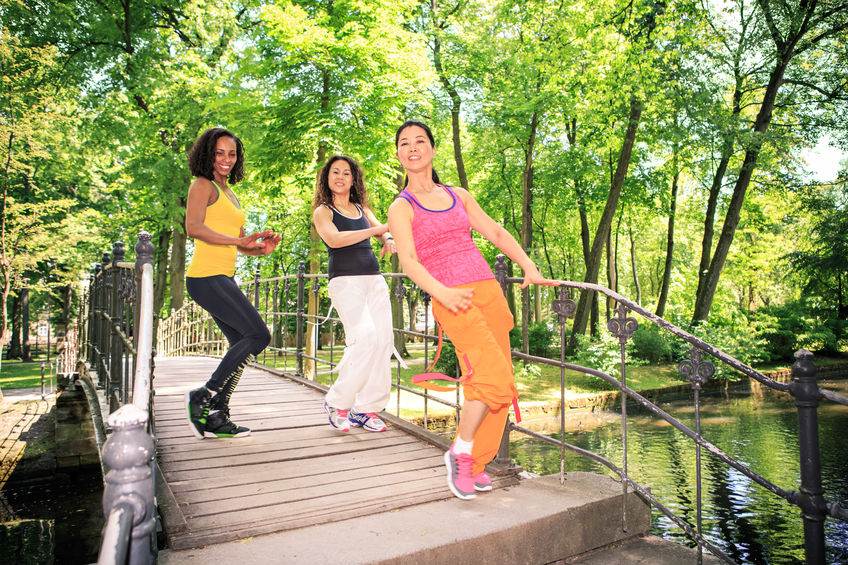Moving Helps Arthritis Pain!
#withDavida
Whenever I must answer why I instruct group exercise classes I think of the people I help like Dolores. She is a petite feisty dark-skinned Puerto Rican matriarch who rarely misses my Tuesday/Thursday morning Zumba class. She has a designated spot in the front center that other patrons, out of respect, leave open for her if she is late.
Dolores will not tell you her age but she will tell you about all of her aches and pains that will give you a hint that she is in her seventh or eighth decade of life. When she arrives in class her moves are slow and heavy. But after a heart thumping warm-up and some fancy foot work her steps lighten and she breaks a smile.
On a good day she is keeping up with everyone and when I ask, “Where’s the party?” In unison with the class she replies “in the basement!” while making a shallow squat. On a bad day, she fades into the second row doing just enough movement to avoid collision while grimacing with any high or low reaching. Regardless of which day she is having, afterwards she says she always feels better. “If I sit still I feel worse”, she tells me.
Like 52 million Americans (1), Dolores has Osteoarthritis, a breakdown and eventual loss of the cartilage in the joints. She mostly feels the pain and swelling in her legs and hips and finds walking across the room a chore similar to hiking a steep mountain. Despite this reaction her doctor tells her to keep attending exercise classes.
According to the Centers for Disease Control and Prevention(2):
no longer do health care providers tell arthritis pain sufferers to rest their joints but instead engage in moderate-intensity, low impact physical activity. It recommends stretching to maintain proper joint range of motion, strengthening exercises to take pressure off the joints and balance exercises to reduce risk of falling.
The CDC says scientific studies have shown participation in such exercise improves pain, function and quality of life without worsening symptoms or the disease. Plus it can delay the onset of disability.
Since there is no cure, preventing the progression of the disease became my motivation when I was diagnosed with arthritis pain in my lower back. Like Dolores I was waking up stiff and having trouble moving from my bed. I found doing some basic yoga moves allowed me to loosen up and feel a little better. But it was a regular regiment of exercises targeting the muscles in the area of inflammation that brought greater relief and sent the disease into remission.
Dolores and I are alike where we try to avoid taking medicine and fear the side effects of ibuprofen(3). For us we’d rather drive to the gym and do the work rather than succumb to stomach cramps, heartburn or more problems associated with taking these types of medications.
It’s hard to find an expert who would disagree with trying exercise first for arthritis pain.
In fact Patience White, M.D., chief public health officer of the Arthritis Foundation says research has found exercise such as walking has been just as effective in reducing knee pain as drugs like naproxen or ibuprofen.
Exercise is also highly recommended by the Arthritis Foundation(4) for rheumatoid arthritis pain, joint inflammation caused by autoimmune disease. Of course, you’ll want to discuss your options with your doctor if suffering from any arthritis pain or conditions.
While taking a painkiller is easier and faster than working out, it won’t keep off the extra pounds, which can make the joint pain worse. It also doesn’t provide the fun atmosphere and friendship Dolores and I enjoy.
Before beginning, discuss any exercise program or changes first with your doctor. Inform your medical professional about your medical conditions and medical history; your doctor can prescribe the best program for you based upon your medical history.
References:
1. http://www.cdc.gov/arthritis/basics/physical-activity-overview.html
2. http://www.cdc.gov/arthritis/basics/physical-activity-overview.html
3. http://www.webmd.com/drugs/2/drug-5166-9368/ibuprofen-oral/ibuprofen-oral/details/list-sideeffects
4. http://www.arthritis.org/living-with-arthritis/exercise/how-to/high-intensity-exercise.php












